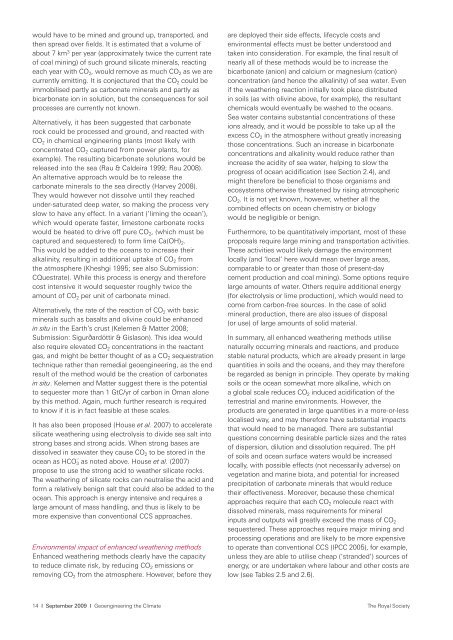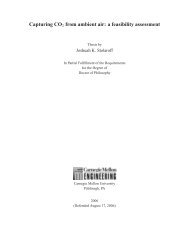Royal Society - David Keith
Royal Society - David Keith
Royal Society - David Keith
Create successful ePaper yourself
Turn your PDF publications into a flip-book with our unique Google optimized e-Paper software.
would have to be mined and ground up, transported, and<br />
then spread over fields. It is estimated that a volume of<br />
about 7 km 3 per year (approximately twice the current rate<br />
of coal mining) of such ground silicate minerals, reacting<br />
each year with CO 2 , would remove as much CO 2 as we are<br />
currently emitting. It is conjectured that the CO 2 could be<br />
immobilised partly as carbonate minerals and partly as<br />
bicarbonate ion in solution, but the consequences for soil<br />
processes are currently not known.<br />
Alternatively, it has been suggested that carbonate<br />
rock could be processed and ground, and reacted with<br />
CO 2 in chemical engineering plants (most likely with<br />
concentrated CO 2 captured from power plants, for<br />
example). The resulting bicarbonate solutions would be<br />
released into the sea (Rau & Caldeira 1999; Rau 2008).<br />
An alternative approach would be to release the<br />
carbonate minerals to the sea directly (Harvey 2008).<br />
They would however not dissolve until they reached<br />
under-saturated deep water, so making the process very<br />
slow to have any effect. In a variant (‘liming the ocean’),<br />
which would operate faster, limestone carbonate rocks<br />
would be heated to drive off pure CO 2 , (which must be<br />
captured and sequestered) to form lime Ca(OH) 2 .<br />
This would be added to the oceans to increase their<br />
alkalinity, resulting in additional uptake of CO 2 from<br />
the atmosphere (Kheshgi 1995; see also Submission:<br />
CQuestrate). While this process is energy and therefore<br />
cost intensive it would sequester roughly twice the<br />
amount of CO 2 per unit of carbonate mined.<br />
Alternatively, the rate of the reaction of CO 2 with basic<br />
minerals such as basalts and olivine could be enhanced<br />
in situ in the Earth’s crust (Kelemen & Matter 2008;<br />
Submission: Sigurðardóttir & Gislason). This idea would<br />
also require elevated CO 2 concentrations in the reactant<br />
gas, and might be better thought of as a CO 2 sequestration<br />
technique rather than remedial geoengineering, as the end<br />
result of the method would be the creation of carbonates<br />
in situ. Kelemen and Matter suggest there is the potential<br />
to sequester more than 1 GtC/yr of carbon in Oman alone<br />
by this method. Again, much further research is required<br />
to know if it is in fact feasible at these scales.<br />
It has also been proposed (House et al. 2007) to accelerate<br />
silicate weathering using electrolysis to divide sea salt into<br />
strong bases and strong acids. When strong bases are<br />
dissolved in seawater they cause CO 2 to be stored in the<br />
ocean as HCO 3 - as noted above. House et al. (2007)<br />
propose to use the strong acid to weather silicate rocks.<br />
The weathering of silicate rocks can neutralise the acid and<br />
form a relatively benign salt that could also be added to the<br />
ocean. This approach is energy intensive and requires a<br />
large amount of mass handling, and thus is likely to be<br />
more expensive than conventional CCS approaches.<br />
Environmental impact of enhanced weathering methods<br />
Enhanced weathering methods clearly have the capacity<br />
to reduce climate risk, by reducing CO 2 emissions or<br />
removing CO 2 from the atmosphere. However, before they<br />
are deployed their side effects, lifecycle costs and<br />
environmental effects must be better understood and<br />
taken into consideration. For example, the final result of<br />
nearly all of these methods would be to increase the<br />
bicarbonate (anion) and calcium or magnesium (cation)<br />
concentration (and hence the alkalinity) of sea water. Even<br />
if the weathering reaction initially took place distributed<br />
in soils (as with olivine above, for example), the resultant<br />
chemicals would eventually be washed to the oceans.<br />
Sea water contains substantial concentrations of these<br />
ions already, and it would be possible to take up all the<br />
excess CO 2 in the atmosphere without greatly increasing<br />
those concentrations. Such an increase in bicarbonate<br />
concentrations and alkalinity would reduce rather than<br />
increase the acidity of sea water, helping to slow the<br />
progress of ocean acidification (see Section 2.4), and<br />
might therefore be beneficial to those organisms and<br />
ecosystems otherwise threatened by rising atmospheric<br />
CO 2 . It is not yet known, however, whether all the<br />
combined effects on ocean chemistry or biology<br />
would be negligible or benign.<br />
Furthermore, to be quantitatively important, most of these<br />
proposals require large mining and transportation activities.<br />
These activities would likely damage the environment<br />
locally (and ‘local’ here would mean over large areas,<br />
comparable to or greater than those of present-day<br />
cement production and coal mining). Some options require<br />
large amounts of water. Others require additional energy<br />
(for electrolysis or lime production), which would need to<br />
come from carbon-free sources. In the case of solid<br />
mineral production, there are also issues of disposal<br />
(or use) of large amounts of solid material.<br />
In summary, all enhanced weathering methods utilise<br />
naturally occurring minerals and reactions, and produce<br />
stable natural products, which are already present in large<br />
quantities in soils and the oceans, and they may therefore<br />
be regarded as benign in principle. They operate by making<br />
soils or the ocean somewhat more alkaline, which on<br />
a global scale reduces CO 2 induced acidification of the<br />
terrestrial and marine environments. However, the<br />
products are generated in large quantities in a more-or-less<br />
localised way, and may therefore have substantial impacts<br />
that would need to be managed. There are substantial<br />
questions concerning desirable particle sizes and the rates<br />
of dispersion, dilution and dissolution required. The pH<br />
of soils and ocean surface waters would be increased<br />
locally, with possible effects (not necessarily adverse) on<br />
vegetation and marine biota, and potential for increased<br />
precipitation of carbonate minerals that would reduce<br />
their effectiveness. Moreover, because these chemical<br />
approaches require that each CO 2 molecule react with<br />
dissolved minerals, mass requirements for mineral<br />
inputs and outputs will greatly exceed the mass of CO 2<br />
sequestered. These approaches require major mining and<br />
processing operations and are likely to be more expensive<br />
to operate than conventional CCS (IPCC 2005), for example,<br />
unless they are able to utilise cheap (‘stranded’) sources of<br />
energy, or are undertaken where labour and other costs are<br />
low (see Tables 2.5 and 2.6).<br />
14 I September 2009 I Geoengineering the Climate The <strong>Royal</strong> <strong>Society</strong>








